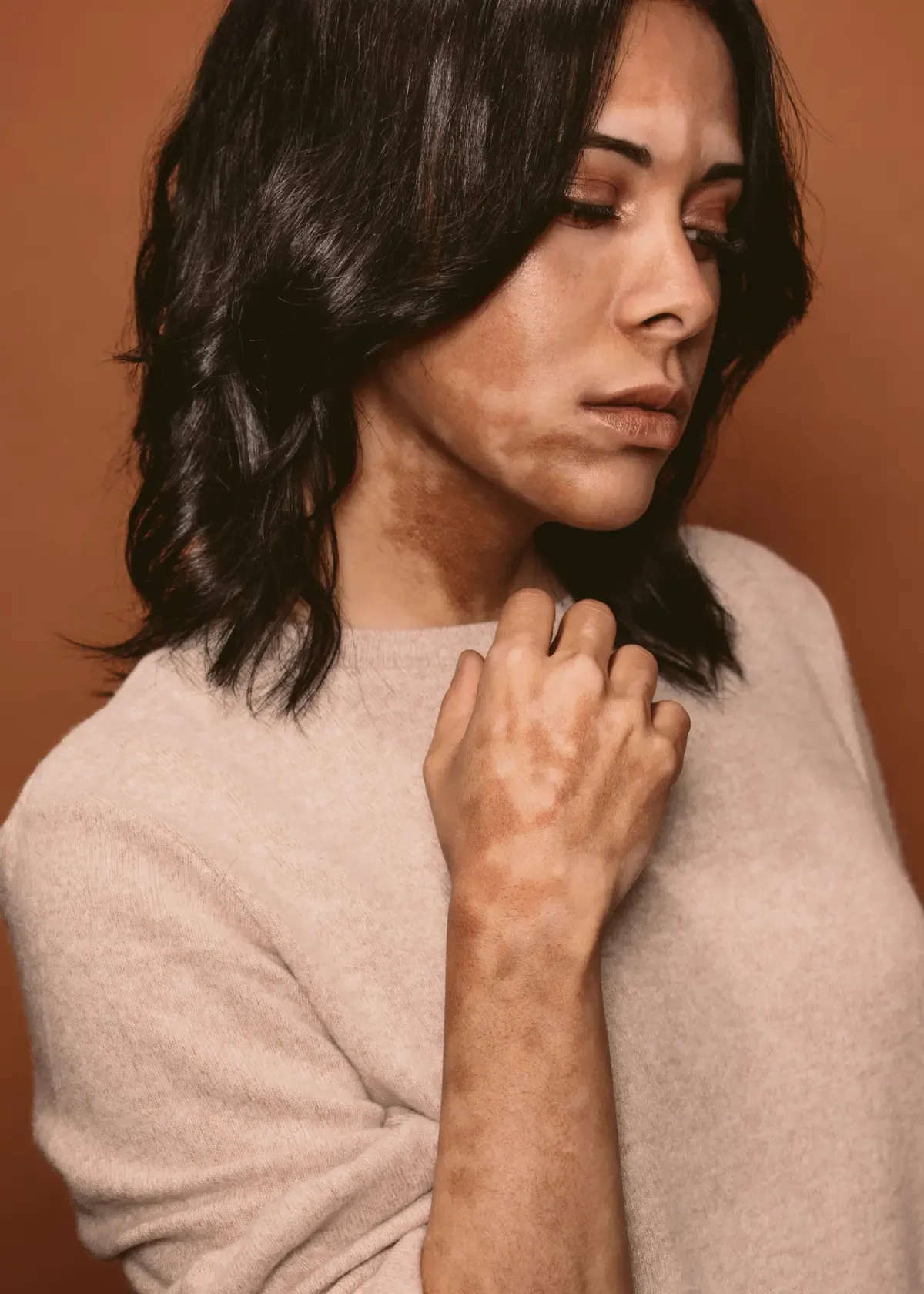Hyperpigmentation is a common skin condition where patches of skin become darker than surrounding areas. This darkening occurs when there is an excess production of melanin, the pigment that gives skin its color.
While hyperpigmentation is harmless, many people seek treatment for cosmetic reasons or because dark spots can make skin appear uneven.
Below, we’ll explore the various causes of hyperpigmentation and how it develops.
Sun Exposure

One of the most common causes of hyperpigmentation is excessive sun exposure. UV rays from the sun can damage skin cells and spur melanin production as a protective measure. With repeated sun exposure, areas of skin that get the most UV radiation will start to produce excess melanin, resulting in darker patches or spots. These darker skin tones are referred to as solar lentigines or "sun spots."
The face, hands, arms, and upper back are typical areas where sun-induced hyperpigmentation occurs because these areas get more sun exposure. The spots may be small and discrete or patchy and diffuse, depending on the amount of UV damage. While sun exposure affects people of all skin tones, those with naturally darker complexions are more prone to developing noticeable sun spots.
Wearing sun protection daily is important to minimize additional sun damage that can worsen skin pigmentation. It's also recommended to avoid peak sun hours, wear protective clothing and hats, and use an SPF lip balm to prevent skin discoloration from developing on the lips.
Hormones

Hormonal changes and fluctuations are another factor that can trigger excess melanin production and cause hyperpigmentation issues. For example, pregnant women may notice the development of dark patches on their face, nipples, or abdomen as their hormone levels change.
Referred to as melasma or "the mask of pregnancy," these darkened areas usually fade after giving birth but may persist or recur with subsequent pregnancies or even menopause.
Birth control pills or hormone replacement therapies can also prompt melasma, particularly in women who have a family history of the condition.
Dark spots and patches may present not just on the face but commonly on the forearms and neck. To reduce the risk of hormonally-induced melasma, doctors may prescribe birth control pills with lower estrogen levels or recommend non-hormonal contraception options.
Inflammation

Skin inflammation can activate melanin production and lead to post-inflammatory hyperpigmentation. This is especially common among those with acne-prone skin. As an acne lesion or pimple heals, it's not unusual for the area to appear darker than the surrounding skin.
Similarly, rashes, eczema, psoriasis, and other inflammatory skin conditions can leave behind dark age spots once the flare-up subsides. The spots occur because inflammation stimulates melanocytes to ramp up melanin synthesis in order to protect the skin against oxidative stress.
To help prevent post-inflammatory hyperpigmentation, it's best not to pick or pop pimples. Seeing a dermatologist to treat and properly heal acne or inflamed skin can minimize the chances of dark marks developing.
Using broad-spectrum sunscreen can also help prevent dark skin color spots from getting darker or more noticeable. If dark marks do occur, topical creams with ingredients like hydroquinone, vitamin C, retinoids, or kojic acid can help fade their appearance over time.
Injuries or Wounds

Just as inflammation prompts excess melanin, so can injuries, wounds, or trauma to the skin. It's common for scrapes, bites, burns, and other damaged skin to heal with darker pigmentation.
Like post-inflammatory hyperpigmentation, this extra melanin is part of the healing process as melanocytes get activated to mend and protect injured skin. However, the end result is often a dark scar or mark.
Those with more melanin in their skin already are more prone to noticeable pigmentation from wounds. But even superficial wounds in those with lighter complexions can induce visible pigmentation as they heal. Applying sunscreen once wounds have closed can help minimize any further darkening.
Certain topical creams may also help lighten pigmented scars over time. More severe injuries like deep cuts, serious burns, and other trauma often result in more conspicuous scarring or hyperpigmentation. But even minor wounds like an insect bite or scraped knee can potentially develop into a dark spot.
Skin Conditions

Certain inflammatory skin conditions are closely associated with hyperpigmentation. Atopic dermatitis, lichen planus, and discoid lupus erythematosus often cause dark patches where the skin has flared up.
Seborrheic dermatitis can also prompt hyperpigmentation on oily areas like the face, scalp, and upper back. Likewise, chronic hives or recurrent rashes from contact allergies may spur excess melanin in affected areas once the inflammation clears.
For some autoimmune disorders like vitiligo, the immune system mistakenly attacks melanocytes, causing white patches to appear. But before the depigmentation occurs, it's common for these same areas to initially develop a darker color in an inflammatory response.
Psoriasis, eczema, acne vulgaris, and other skin conditions that involve inflammation can similarly produce hyperpigmentation as a side effect. Keeping the underlying condition well-controlled is key.
Melanoma

While most causes of hyperpigmentation are benign, dark spots or unusual moles can also signal a rare but serious concern: melanoma. Melanoma is a type of skin cancer that occurs when melanocytes mutate and grow out of control.
In its early stages, melanoma typically appears as an unusual mole or dark patch. Changes in the shape, color, size, or symmetry of a mole are considered warning signs of melanoma.
It's important to periodically examine your skin for any new or changing dark spots. Look for moles that are asymmetrical, have irregular borders, vary in color, are larger than a pencil eraser, or have recently changed in appearance.
Check all sun-exposed areas and between the toes, palms, and soles where melanomas also commonly develop. If you notice any unusual pigmented spots, promptly see a dermatologist to determine if a biopsy is recommended. Catching melanoma early is crucial for successful treatment.
Different Ways to Treat Hyperpigmentation

There are various options for treating hyperpigmentation, including over-the-counter creams, prescription treatments, professional procedures like chemical peels or laser therapy, and making lifestyle changes to prevent further pigmentation.
Over-The-Counter Options
There are several over-the-counter options available for treating hyperpigmentation. These products can help lighten dark spots and even out the skin tone. Here are some common over-the-counter treatments you can try:
- Topical creams: Look for creams or serums that contain ingredients like hydroquinone, kojic acid, alpha-hydroxy acids (AHAs), or retinol. These ingredients work by inhibiting melanin production and promoting skin cell turnover.
- Brightening serums: Serums infused with vitamin C, niacinamide, or licorice extract can help reduce hyperpigmentation and brighten the skin.
- Exfoliating scrubs: Gentle exfoliation can help remove dead skin cells and promote new cell growth. Look for scrubs with ingredients like glycolic acid or salicylic acid for effective exfoliation.
- Spot treatments: Target specific areas of hyperpigmentation with spot treatments containing active ingredients such as azelaic acid or cortisone.
- Natural remedies: Some natural remedies like lemon juice, aloe vera gel, and green tea extract may have mild lightening effects on hyperpigmented areas.
Prescription Treatments
Prescription treatments for hyperpigmentation include:
- Topical creams: Dermatologists may prescribe creams containing ingredients such as hydroquinone, retinoids, corticosteroids, or kojic acid. These creams work by inhibiting melanin production or promoting cell turnover to reduce the appearance of dark spots.
- Chemical peels: A dermatologist can perform a chemical peel using stronger concentrations of acids, such as alpha-hydroxy acids or trichloroacetic acid. This procedure removes the top layer of skin, revealing fresher and more evenly toned skin underneath.
- Laser therapy: Laser treatments target hyperpigmented areas with intense light energy, breaking up excess melanin and stimulating collagen production. This helps fade dark spots and improve overall skin tone.
- Microdermabrasion: During this treatment, a dermatologist uses a handheld device to gently exfoliate the skin's surface. By removing dead skin cells and promoting cell turnover, microdermabrasion can lighten hyperpigmented areas over time.
Professional Procedures
Professional procedures can be effective in treating hyperpigmentation. These treatments are usually performed by dermatologists or skincare professionals. Some commonly used professional procedures for hyperpigmentation include:
- Chemical peels: A chemical solution is applied to the skin to remove the top layers, promoting new skin growth and reducing the appearance of dark spots.
- Laser therapy: Intense beams of light are used to target and break down excess melanin in the skin, helping to lighten areas of hyperpigmentation.
- Microdermabrasion: This procedure uses a special tool to exfoliate the outer layer of skin, improving texture and reducing pigmentation irregularities.
- Cryosurgery: Liquid nitrogen is used to freeze and destroy unwanted pigmented cells, allowing new, healthy skin cells to regenerate.
- Dermabrasion: A high-speed rotating brush or diamond-tipped instrument is used to gently remove the outer layer of skin, revealing fresher, more even-toned skin.
- IPL (Intense Pulsed Light) therapy: Intense pulses of light are used to target melanin in the skin, breaking up areas of hyperpigmentation without damaging surrounding tissues.
- Photofacial: Also known as an IPL photorejuvenation treatment, it uses intense pulsed light technology to improve skin tone and reduce hyperpigmentation.
- Radiofrequency treatments: Radiofrequency energy heats the deeper layers of the skin, stimulating collagen production and improving overall complexion.
Lifestyle Changes for Prevention
To prevent hyperpigmentation and maintain an even skin tone, consider making these lifestyle changes:
- Protect your skin from the sun: Use sunscreen with a high SPF daily, wear protective clothing, and seek shade during peak sun hours.
- Avoid picking or popping pimples: This can lead to postinflammatory hyperpigmentation.
- Be gentle with your skin: Avoid harsh scrubbing or exfoliation that can irritate the skin and trigger melanin production.
- Maintain a healthy diet: Eat a balanced diet rich in antioxidants to help protect the skin from free radical damage.
- Manage stress levels: Chronic stress can increase inflammation in the body and contribute to hyperpigmentation.
- Limit exposure to environmental pollutants: Certain pollutants can worsen pigmentation issues, so try to avoid unnecessary exposure.
- Quit smoking: Smoking damages the skin and increases the risk of hyperpigmentation.
- Stay hydrated: Proper hydration supports overall skin health and can help reduce the appearance of dark spots.
- Consider using gentle skincare products: Opt for products specifically formulated for hyperpigmentation that contain ingredients like vitamin C, kojic acid, or niacinamide.
- Regularly cleanse your face before bed: Removing makeup, dirt, and impurities helps keep your skin healthy and reduces the risk of clogged pores leading to inflammation and pigmentation issues.
Frequently Asked Questions
Hyperpigmentation can be stubborn and confusing to treat. You may still have questions about the best ways to fade or prevent dark spots. Below are some frequently asked questions and answers regarding hyperpigmentation:
What causes so much hyperpigmentation on my skin?
Excess pigmentation in the skin often results from hyperpigmentation causes such as sun exposure, hormonal changes, or inflammation.
How does skin darkening relate to hyperpigmentation?
Skin darkening is a common symptom of hyperpigmentation as it involves the production of excess pigment, leading to dark spots on the skin.
Are there treatments for reducing hyperpigmentation?
Yes, several treatments, like using specific creams, can help with hyperpigmentation and reduce the appearance of dark spots on your skin.
Are home remedies effective against hyperpigmentation?
There are various home-based remedies available that can assist in managing and improving symptoms of Hyperpigmentation when applied appropriately.
Conclusion
Once the cause of hyperpigmentation is clear, your dermatologist will recommend treatment steps. Topical creams containing hydroquinone, retinoids, vitamin C, and kojic acid can help fade pigmented areas over time.
Chemical peels and microdermabrasion gently remove the top layers of skin to promote skin cell turnover and lighten dark spots. For more significant hyperpigmentation, laser or light therapies can selectively target and destroy excess melanin deposits.
If melanoma or another serious skin condition is diagnosed, more advanced treatments like surgical excision, immunotherapy medications, or chemotherapy may be required.
But when caught early, melanoma is often treated with a simple wide local excision of the skin cancers. Your dermatologist can walk you through the different treatment stages if any concerning moles are identified.



